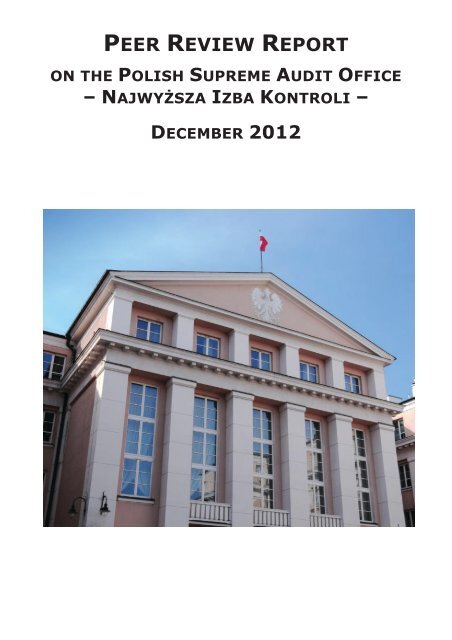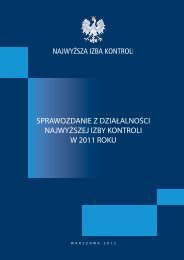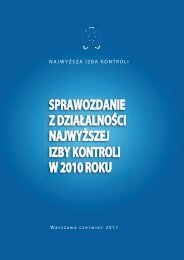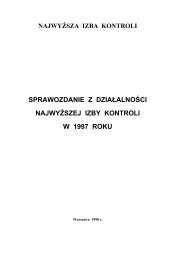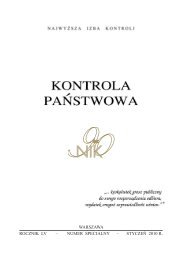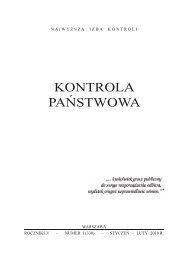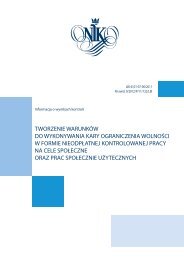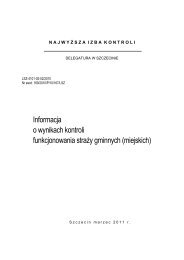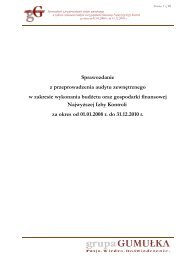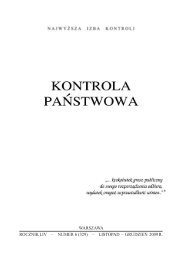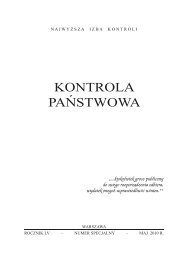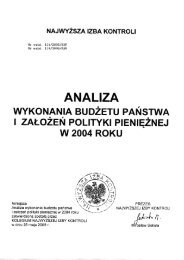NIK peer review report - Najwyższa Izba Kontroli
NIK peer review report - Najwyższa Izba Kontroli
NIK peer review report - Najwyższa Izba Kontroli
Create successful ePaper yourself
Turn your PDF publications into a flip-book with our unique Google optimized e-Paper software.
PEER REVIEW REPORTON THE POLISH SUPREME AUDIT OFFICE– NAJWYŻSZA IZBA KONTROLI –DECEMBER 2012
This <strong>peer</strong> <strong>review</strong> <strong>report</strong> was prepared by representatives of the SAIsof Austria, Denmark (team leader), Lithuania and the Netherlands,December 2012
Table of contentsExecutive Summary .......................................................................... 51. Purpose and Background ............................................................... 62. Main Conclusions, Strengths and Recommendations ......................... 83. Audit Selection and Planning ......................................................... 114. Implementation ........................................................................... 185. Reporting ................................................................................... 256. Follow-up ................................................................................... 28Attachment 1. About the Peer Review ................................................. 30Attachment 2. List of Audit Cases Reviewed ......................................... 33Attachment 3. List of Persons Interviewed for the Peer Review ................ 34December 2012
Executive SummaryThe Polish Supreme Audit Office, Najwyższa <strong>Izba</strong> <strong>Kontroli</strong> (<strong>NIK</strong>), requesteda <strong>peer</strong> <strong>review</strong> of its audit approach including audit selection,planning, implementation, <strong>report</strong>ing and follow-up. The <strong>peer</strong> <strong>review</strong> wascarried out in 2012 by representatives of the Supreme Audit Institutions(SAIs) of Austria, Denmark (team leader), Lithuania and the Netherlands.The purpose was to identify areas that may benefit from improvement andgood practice. Specifically, <strong>NIK</strong> wanted to obtain assurance that it is compliantwith professional standards, improve its transparency, learn fromother SAI’s experience in the areas of interest and improve key businessareas.The <strong>peer</strong>s based the assessment of <strong>NIK</strong>’s audit activities on a combinationof international standards as defined by the International Organisation ofSupreme Audit Institutions (INTOSAI) in the International Standards ofSupreme Audit Institutions (ISSAIs) and the <strong>peer</strong>s’ experience with goodaudit practice.The <strong>peer</strong>s concluded that <strong>NIK</strong> operates in line with professional standards.In the audits <strong>review</strong>ed, the <strong>peer</strong>s did not identify any deviations from professionalstandards.The basic international standards are currently being updated by IN-TOSAI. The <strong>peer</strong>s recommended that <strong>NIK</strong> undertake a general gap analysesin order to identify possible differences between the standards and<strong>NIK</strong>’s internal guidelines.The <strong>peer</strong>s found that <strong>NIK</strong> has a wide range of strengths to draw on andthat <strong>NIK</strong> is well geared to making a positive contribution to the public sectorin Poland. Covering the entire audit approach including audit selectionand planning, implementation, <strong>report</strong>ing and follow-up the <strong>peer</strong>s made 11recommendations. These are to be understood against the background ofthe <strong>peer</strong>s’ general assessment of <strong>NIK</strong>’s strengths.The <strong>peer</strong> <strong>review</strong> did not include changes made at <strong>NIK</strong> during 2012 asthe <strong>review</strong> mainly covered audits completed in 2011. In 2012, <strong>NIK</strong> introducedchanges to the planning procedure as well as changes as a result ofthe amendment of the Act on the <strong>NIK</strong>. <strong>NIK</strong> has informed the <strong>peer</strong>s aboutthese changes and it is the opinion of <strong>NIK</strong> that they are in line with therelevant recommendations of the <strong>peer</strong>s.PEER REVIEW REPORT 5
Memorandum of Understanding(MoU)The MoU was signed 18January 2012 by the Presidentof <strong>NIK</strong> and the SAIsof Austria, Denmark, Lithuaniaand the Netherlands.The MoU sets out the purposeand mode of cooperationof the <strong>peer</strong> <strong>review</strong>.1. Purpose and BackgroundThe Polish Supreme Audit Office, Najwyższa <strong>Izba</strong> <strong>Kontroli</strong> (<strong>NIK</strong>), hasrequested a <strong>peer</strong> <strong>review</strong> of its audit approach. The <strong>peer</strong> <strong>review</strong> was carriedout based on a Memorandum of Understanding (MoU) signed by thePresident of <strong>NIK</strong> and representatives of the Supreme Audit Institutions(SAI) of Austria, Denmark (team leader), Lithuania and the Netherlands.According to the MoU the purpose of the <strong>peer</strong> <strong>review</strong> was to identify areasthat may benefit from improvement and good practice. Specifically the objectivesof the <strong>peer</strong> <strong>review</strong> were to:- obtain assurance that <strong>NIK</strong> is compliant with professional standards;- improve the transparency of <strong>NIK</strong>;- learn from other SAI’s experience in the areas of interest and improvekey business areas.The scope of the <strong>peer</strong> <strong>review</strong> was defined to cover <strong>NIK</strong>’s audit approachincluding audit selection, planning, implementation, <strong>report</strong>ing andfollow-up. The <strong>review</strong> included <strong>NIK</strong>’s audit procedures and how these areapplied in the audit work, as well as <strong>NIK</strong>’s guidelines, policies and strategies.The <strong>review</strong> covered the different types of audits conducted by <strong>NIK</strong>.ISSAIThe International Standardsof Supreme Audit Institutions(ISSAIs) are a collectionof professional standardsand best practiceguidelines for public sectorauditors, officially authorisedand endorsed by theInternational Organisationof Supreme Audit Institutions(INTOSAI).The ISSAIs state the basicprerequisites for the properfunctioning and professionalconduct of Supreme AuditInstitutions and the fundamentalprinciples in auditingof public entities.The <strong>peer</strong>s carried out the <strong>review</strong> on the spot during the first half of 2012.As agreed with <strong>NIK</strong> the <strong>review</strong> should cover already completed audits sothat the entire audit process from beginning to end could be analysed andthe <strong>peer</strong>s’ assessment supported by factual documentation. Thus, the <strong>review</strong>did not cover the changes introduced at <strong>NIK</strong> during 2012. Changesinclude both a new planning procedure and changes as a result of theamendment of the Act on <strong>NIK</strong>. <strong>NIK</strong> has informed the <strong>peer</strong>s about thesechanges and it is the opinion of <strong>NIK</strong> that they are in line with the relevantrecommendations of the <strong>peer</strong>s.The <strong>peer</strong>s based their assessment of <strong>NIK</strong>’s audit activities on a combinationof international standards as defined by INTOSAI in the ISSAIs andthe <strong>peer</strong>s’ experience with good audit practice.Further details on the contents of the <strong>peer</strong> <strong>review</strong> can be found in attachment1.About the Najwyższa <strong>Izba</strong> <strong>Kontroli</strong>The State Budget ExecutionAudit (SBEA) is <strong>NIK</strong>’smost important task. TheSBEA is published annuallyin a document called “Analysisof the execution of thestate budget and monetarypolicy guidelines” and ispresented to the Sejm.<strong>NIK</strong> is the principal authority of government auditing in Poland. <strong>NIK</strong> issubordinate to the Sejm, the lower chamber of the Polish Parliament.<strong>NIK</strong> submits its <strong>report</strong>s to the Sejm. The most significant <strong>report</strong>s are theanalysis of the state budget execution, pronouncements on results of specificaudits and the annual <strong>report</strong> on <strong>NIK</strong>’s activities. In the state budgetexecution audit (SBEA) <strong>NIK</strong> discharges the entire state budget. Pronouncementson results of audits are presented in audit <strong>report</strong>s dealing6 PEER REVIEW REPORT
with a wide range of subject matters covering state, regional and local authorityissues.In 2011 <strong>NIK</strong> carried out 197 planned and 213 ad hoc audits covering variousareas of state activity. 202 of these <strong>report</strong>s on the results of auditswere submitted by <strong>NIK</strong> to the Sejm and 95 of these concerned the SBEA.The activities of <strong>NIK</strong> are regulated by the Act on <strong>NIK</strong>. The Act regulatesboth <strong>NIK</strong>’s tasks and the scope of activities as well as issues regarding<strong>NIK</strong>’s internal organization, audit procedures and staff. The Act wasamended in January 2010 with changes in the audit procedure taking effectas of June 2012.Act on <strong>NIK</strong>Supreme Audit Office Act of23 December 1994amended 22 January2010.The President of <strong>NIK</strong> is appointed by the Sejm for a six-year term ofoffice. Organizationally <strong>NIK</strong> is divided into a Central Office in Warsaw and16 regional branches – one in each administrative region of Poland. TheCentral Office comprises 14 audit departments covering the audit of stateactivities, and four administrative staff functions, which provide internalservices to the organization. The 16 regional branches and the 14 auditdepartments are all directly involved in auditing.Approximately half of <strong>NIK</strong>’s 1,700 employees work in the branch offices.PEER REVIEW REPORT 7
2. Main Conclusions, Strengths andRecommendationsSee ISSAI 20 Principles oftransparency and accountabilityThe <strong>peer</strong>s consider the request for a <strong>peer</strong> <strong>review</strong> a way of improvingthe transparency of <strong>NIK</strong>. Improving transparency was one of the specificobjectives of the <strong>peer</strong> <strong>review</strong> as described in the MoU.In the MoU <strong>NIK</strong> asked for assurance that it is compliant with professionalstandards. The <strong>peer</strong>s have concluded that <strong>NIK</strong> operates in line withprofessional standards. In the audits <strong>review</strong>ed, the <strong>peer</strong>s did not identifyany deviations from professional standards.The basic international standards (ISSAI 100, 200, 300 and 400) arecurrently being updated by INTOSAI. The <strong>peer</strong>s have not directly comparedall <strong>NIK</strong>’s procedures with the specific requirements of the ISSAIs.An analysis to assure that <strong>NIK</strong>’s internal guidelines are in line with the IS-SAIs is a major exercise that might be undertaken by <strong>NIK</strong> itself graduallyover a number of years. Such an analysis could provide <strong>NIK</strong> with an opportunityto reflect on its current audit practice. The <strong>peer</strong>s suggest that<strong>NIK</strong> considers undertaking a gap analysis of the differences between itsinternal guidelines and the ISSAIs.In line with the MoU, the <strong>review</strong> was aimed at identifying possible areasof improvement and in the <strong>report</strong> the <strong>peer</strong>s present observations andfindings from which <strong>NIK</strong> might benefit.In accordance with the MoU, this <strong>report</strong> focuses on <strong>NIK</strong>’s audit approach,including audit selection, planning, implementation, <strong>report</strong>ing and followup.The <strong>peer</strong>s have found that <strong>NIK</strong> has a wide range of strengths to draw on:8 PEER REVIEW REPORT
STRENGHTSWell-qualified staff resources are available and <strong>NIK</strong> is consideredan attractive workplace. <strong>NIK</strong> has a particularly strong position infinancial and regularity auditing. Furthermore, <strong>NIK</strong> has access toin-house specialists in a number of areas and has the possibilityof consulting experts and specialists when relevant. <strong>NIK</strong> providesinternal staff training and aims at offering employees commensurateterms and conditions of employment.ISSAI 1 The Lima Declaration,Section 14 Audit Staff<strong>NIK</strong> is continually evolving and developing. The development hasbeen described by stakeholders and <strong>NIK</strong> itself as a transition towardsa more partner-like approach.Stakeholders perceive <strong>NIK</strong> as an independent authority with highcredibility. In general, <strong>NIK</strong> is highly respected.<strong>NIK</strong> has a proactive approach to the media and to publishing auditresults and communicates openly with the public about audit<strong>report</strong>s. Press contact is systematic and well-established. Furthermore,<strong>NIK</strong> has a well-functioning website with informationthat provides insight into <strong>NIK</strong>’s work. Among other things, <strong>NIK</strong>has made its assessment criteria for the SBEA publicly availableand publishes its annual work plan.The collaboration between <strong>NIK</strong> and the auditees runs accordingto well-established procedures. Comments and reservations ofthe auditees are taken into account and mentioned in the <strong>report</strong>s.The internal procedures are in writing and cover all aspects ofthe audits. Organizationally, <strong>NIK</strong> audits are managed with asteady hand – there is a relevant set-up with auditors, coordinators,advisers, management and specialist units providing advicein special areas like, for instance, law. Internal quality control,management supervision and documentation of audit cases seemto cover all substantial areas of the audit approach.The majority of the audits that were presented to the <strong>peer</strong>s dealtwith relevant and substantial issues. Some of the audit topicstreated were innovative and dealing with important societal issues,which demonstrate that <strong>NIK</strong> is selecting audit topics of relevanceto the Polish society and its citizens. This open-mindedapproach is generally confirmed by the stakeholders, who emphasizethat the audits performed by <strong>NIK</strong> tend to spark interestand debate and are considered important contributions.PEER REVIEW REPORT 9
It is the <strong>peer</strong>s’ general conclusion that <strong>NIK</strong> is well geared to making apositive contribution to the public sector in Poland. The following recommendationsare formulated against this background and aimed at areasthat may benefit from improvement:RECOMMENDATIONS# 1. Continue to focus the audit selection process to ensure a morerisk-based approach# 2. Consider moving further in the direction of conducting systemanalysis and scaling down substance auditing# 3. Consider the benefits of cross-cutting analysis and assure thatfindings and recommendations are directed at the appropriate levelin the line of responsibility# 4. Consider procedures for awarding resources to the individualaudit more flexibly depending on the scope and risk of the audit# 5. Continue to increase further the element of performance auditing# 6. Strengthen dialogue with the auditees# 7. Increase the involvement and participation of auditors at allstages of the audit, e.g. by strengthening teamwork and using aproject-oriented approach to audits# 8. Continue to focus on improving the readability of the audit <strong>report</strong>s# 9. Increase the use of positive examples in audit <strong>report</strong>s to increaselearning among auditees#10. Consider using external assessments in quality assurance ofaudit <strong>report</strong>s# 11. Strengthen the follow-up on audit results and recommendationsIn the subsequent chapters of this <strong>report</strong>, the recommendations are describedin more detail.10 PEER REVIEW REPORT
3. Audit Selection and PlanningThe planning stage is an important part of the audit procedure andserves to ensure that the audits cover relevant areas and issues and thatthe audits performed by <strong>NIK</strong> add maximum value to the Polish public sectorand Parliament.See ISSAI 3100 PerformanceAudit Guidelines –Key Principles, par. 2.4.1.PlanningRecommendation # 1. Continue to focus the audit selection processto ensure a more risk-based approach<strong>NIK</strong> has laid down a strategy and set priorities for selecting audit topicsand submits an annual work plan with audit themes to the Sejm.Audit selection is to a large degree a bottom-up process. Departmentsand branches suggest audit topics, and management screens and selects.Sejm – the lower Chamberof the Polish Parliament.<strong>NIK</strong> <strong>report</strong>s are sent to theresponsible committees inthe Sejm. At the Sejm theState Audit Committee isresponsible for the activitiesof <strong>NIK</strong>.The process is guided by audit priority directions that support the selectionprocess. Until 2012 the priorities were rather broadly defined. The<strong>peer</strong>s find that the priorities have helped <strong>NIK</strong> in its efforts to focus the selectionprocess but that they could have be used further to guide the selectionof audit topics.<strong>NIK</strong> has a less stringent procedure for choosing ad hoc audits. By naturead hoc audits are more loosely defined, but they should follow generaland systematic selection criteria.Until 2012 where a new planning procedure was introduced at <strong>NIK</strong>branches and departments <strong>NIK</strong> largely decided whether they wished toparticipate in an audit and which audit topics they wanted to advocate tomanagement. This approach is motivational, but care must be taken toensure that significant topics across branches and departments are auditedand selected according to a risk-based approach.Departments andbranches<strong>NIK</strong> is divided into a CentralOffice in Warsaw and 16regional branches. TheCentral Office contains 14audit departments and 4administrative departments.Based on the cases <strong>review</strong>ed the <strong>peer</strong>s are of the opinion that especiallyfor the ad hoc audits it is important to focus the selection process to ensurethat risk and materiality is considered on a more global scale and notonly in relation to the topic at hand. Ideally, the selection process shouldbe organised to ensure that the risk and materiality assessment spans notonly the individual auditees and audits but also the entire public sector.A more risk-based approach to the selection of audits leads to a more efficientallocation of resources.Several of the <strong>peer</strong> SAIs use a system or database for integrated riskanalysis when monitoring auditees and preparing risk analysis for planningpurposes. The purpose of using such a system is to make sure that planningand monitoring of auditees is based on a common framework.Since March 2012 <strong>NIK</strong> has applied a new method for audit planningthat is more centralized and strategically founded. <strong>NIK</strong> has informed thePEER REVIEW REPORT 11
<strong>peer</strong>s that the work plan for 2013 is being elaborated with a new approachto selecting audit topics. For instance audit priority directions are morenarrowly defined and more precisely aimed at particular government activities.Recommendation # 2. Consider moving further in the direction ofconducting system analysis and scaling down substance auditingEnsuring that the administration has well-functioning internal controlsystems is an important part of selecting and planning audits on the basisof a risk-based approach.System audits test the internalcontrol measures ofthe auditee.<strong>NIK</strong> has procedures in place to gain an initial understanding of the keymanagement systems of the auditee prior to the audit. For instance, <strong>NIK</strong>uses risk analyses when planning audits and each auditor is required tomake him- or herself acquainted with the internal control systems that areapplied by the auditee.Substance audits test selectedsamples and transactions.The purpose of systemsaudit is to assess theprocesses and internal controlsystems of the auditee.The purpose of substanceaudit is to reach a reasonablelevel of assurance thatthe transaction or the accountsare accurate.This prior knowledge of the auditees’ systems is, however, not alwaysused in the subsequent audit. In the cases <strong>review</strong>ed, the system analysisdoes not always seem to guide the deployment of audit resources andconsequently too many resources may be committed to substance auditing.The advantage of performing system-based audits is that a higherlevel of certainty is obtained using fewer resources compared to substanceaudits.Generally, the <strong>peer</strong>s found that systems-related risks are rankedequally with other types of risk. The risk analysis therefore does not systematicallytarget the system-level.The assumption is that if control systems are in place and wellfunctioning,the impact of other risks will be of minor importance. Thus,<strong>NIK</strong> might consider how to ensure that super- or subordinate risks are notranked equally and that especially systems-related risks are prioritized inorder to improve the effectiveness of the audits.Ensuring that the auditees have well-functioning internal control or managementcontrol systems would eventually allow <strong>NIK</strong> to rely more on thesystems and scale down substance auditing.<strong>NIK</strong> has performed specific audits of internal audit within the system ofmanagement control across various sectors. This is a good example of <strong>NIK</strong>setting an agenda and addressing the general issue of management controlsystems.See ISSAI 1610 Using theWork of Internal Auditors<strong>NIK</strong> might also look for ways of making better use of the work performedby the internal audit units. This includes assessing their independence andthe audit findings presented as well as helping them develop their auditmethodologies. The purpose would be to strengthen the control systemsand through collaboration stimulate the work of the internal auditors.12 PEER REVIEW REPORT
Examples of the use of internal auditors’ workThe level of cooperation between SAI’s and internal audit units depends onthe political and legal framework. In the following, a number of examples ofclose cooperation between the <strong>peer</strong> SAIs and internal audit units are presented.These are meant for inspiration only and cannot be directly implementedin a Polish context.In one case, the internal audit department certifies the annual accounts of theministries at the national level. Still, the SAI provides assurance on the consolidatedstate accounts. For this, the state accounts are annually submittedto the SAI for approval. The SAI relies heavily on the audit findings of the internalauditors of the ministries in order to get a sound basis for an opinion onthe state accounts. Therefore, the SAI can direct a significant part of its auditcapacity to performance audits instead of auditing the annual accounts.In another case, the act governing the activities of the SAI in question stipulatesthat the SAI can carry out audits in close cooperation with the internalauditors of the government institutions. The SAI uses the work of the internalauditors to fulfil its audit mandate. The role of the SAI is to advise and supervisethe internal auditors and to evaluate their planning and work to makesure that the demands of the SAI are met.In a third case, the SAI has established cooperation with internal audit unitsin so-called task forces, where the SAI helps develop audit methodologies etc.The purpose is to evolve the internal audit units in order for the SAI to be ableto rely more on their work.The SBEA audit approach in relation to systems-based auditingFor all auditees the same accounting and <strong>report</strong>ing principles apply.These are laid out in the Accounting Act and the Public Finance Act. However,the auditees use a large number of different IT-solutions for their financialand accounting systems and different accounting techniques.Thus, the SBEA audits are required to cover several hundred different accountingsystems, as no consolidated and harmonised IT-accounting systemexists across the Polish public administration. This means that theaudit of the state accounts is a very resource intense task for <strong>NIK</strong>.The <strong>peer</strong>s suggest that <strong>NIK</strong> should increase the joint efforts made in collaborationwith the Ministry of Finance to improve the accounting and accountabilitysystem of central government and reduce the scope of theSBEA. A more uniform accounting system would improve transparencyand further enable the public to hold public bodies to account. Furthermoreit would facilitate <strong>NIK</strong>’s work and provide <strong>NIK</strong> with further opportunitiesto look into priority areas.SBEA – The State BudgetExecution Audit is <strong>NIK</strong>’sannual discharge of thestate budget.Formally, it is called the“Analysis of the state budgetexecution and monetarypolicy assumptions” and itconsists of a range of auditsof each item on thestate budget as well as anaudit of the monetary policy.The SBEA commits alarge part of <strong>NIK</strong>’s resources,i.e. almost 45,000working days every year.Being able to work on the basis of consolidated accounts and solid accountingstatements from the auditees would allow <strong>NIK</strong> to use its resourcesmore efficiently and improve accountability.In general, <strong>NIK</strong> has to fulfil a broad audit mandate including severallayers of government (central, regional and local), state-owned and subsidizedcompanies, etc.PEER REVIEW REPORT 13
In the SBEA <strong>NIK</strong> covers the account items very broadly. <strong>NIK</strong> is free tochoose its audit procedures, but is expected by the Sejm to cover specificaccount items at regular intervals.<strong>NIK</strong> has informed the <strong>peer</strong>s that <strong>NIK</strong> has introduced a number of changesin the audit methodology that reduce the level of sampling depending onthe materiality, for instance so-called purpose-based sampling. Thesechanges have been applied to audits carried out in 2012.Description of selection of auditees under the SBEABelow ministerial level, <strong>NIK</strong> is free to leave accounts unaudited in the SBEA.The SBEA includes 3rd or 4th level administrators. At the 1st level (ministries),all entities are audited every year. At lower levels (with lower risk) <strong>NIK</strong>is free to leave accounts unaudited or conduct simplified audits. In total about10% of the about 3,000 entities, corresponding to 270-300 entities, are auditedevery year (administrators at the lowest levels are audited every 6-7years).<strong>NIK</strong>’s approach ensures broad coverage of all accounts. The inherent riskhas been that the effort is not sufficiently targeted to the most risk-proneareas. The recent changes in audit procedures will according to <strong>NIK</strong> assuremore focus on the inherent risk and areas identified in the risk analysis.In order to assure broad coverage of the state budget <strong>NIK</strong>s selection processis guided not only by substantial risk analysis, but also by a principleof rotation. Minor units thus might receive more attention than significantlyrisky areas.Consequently, <strong>NIK</strong>’s challenge is to prioritize further among the auditedentities. <strong>NIK</strong> might to a larger degree determine the level of resources tobe allocated to each individual audit every year based on an assessmentof risk and materiality. One way of doing this is to move further in the directionof conducting systems analysis and scale down substance auditingin the individual accounts.Moving in this direction would probably increase the transparency of theaudit principles and offer the advantages of a more system-based approach,i.e. a more efficient use of resources and a more risk-based approachto audit selection. Reducing the level of substance auditing, on theother hand, would force <strong>NIK</strong> to present more information on the methodologyused and the level of coverage and assurance, i.e. <strong>NIK</strong> does notroutinely cover all items, but targets the most risky and significant areas.<strong>NIK</strong> has informed the <strong>peer</strong>s that <strong>NIK</strong> continually strives at applying a morerisk-based approach.Among the cases <strong>review</strong>ed – also cases outside the SBEA – the <strong>peer</strong>snoticed several audits that included very large samples of auditees thatrequired large-scale audits involving many branches and auditors. The14 PEER REVIEW REPORT
<strong>peer</strong>s agree with <strong>NIK</strong> that sampling and the size of samples should bebased on an individual assessment considering many factors. Considerationson how to get an optimum of assurance balanced against availablestaff resources should always be based on sound methodological choices.However, a more risk-based approach to the audit sampling could haveresulted in a more focused and efficient use of resources.Examples of sampling in <strong>NIK</strong> auditsIn the audit of the implementation of tasks to prevent overweight and obesityprevention among children and adolescents (P/10/190) a total of 74 entitieswere included in the sample audited. Among the auditees were many schoolsetc. The <strong>peer</strong>s did not <strong>review</strong> the basis for the sampling and the methodologyused, but it is worth considering, if the same results might have beenachieved with a smaller sample. <strong>NIK</strong> has specified that sample size in thiscase also was a matter of assuring the credibility of the <strong>report</strong>.In the audit of the execution of the government programme “My sports field –Orlik 2012” by local government administrative units (P/10/146), the initialrisk analysis indicated that auditees in the bigger cities should be excluded.The entities finally included in the audit were chosen because they volunteeredto participate in the audit.Recommendation # 3. Consider the benefits of cross-cutting analysisand assure that findings and recommendations are directed atthe appropriate level in the line of responsibilityAs a SAI <strong>NIK</strong> is in a favourable position to look at aspects across thepublic sector, i.e. across sectors and across levels of responsibility.When it is decided which type of audit that should be performed, the governmentallevel of responsibility towards which the audit should be directedshould be carefully considered. In a number of the cases <strong>review</strong>ed,the <strong>peer</strong>s discussed whether a different audit design might have allowed<strong>NIK</strong> to direct its reservations at the level responsible for the design, monitoringor control of a particular programme instead of only addressing thelevel executing the programme. <strong>NIK</strong> is in an excellent position to addresssuch issues and the <strong>peer</strong>s find that <strong>NIK</strong> should utilize this position to itsfull potential.In a number of cases, the <strong>peer</strong>s found that audit findings reflecting problemsof a general nature could have been addressed at a general governancelevel. Issues relating to programme design were not addressed atthe level of governance responsible for designing the programme, but atthe level of the units that were executing the programme.See ISSAI 1260 Communicatingwith thoseCharged with Governance.Specific findings and recommendations of individual audits could to ahigher degree be supplemented with general comments designed to holdthe relevant ministry accountable in order to improve, for instance, ministerialsupervision or governance structures.PEER REVIEW REPORT 15
The purpose would furthermore be to ensure accordance between competenceand responsibility.Examples where responsibility might be directed at a higher levelIn a <strong>report</strong> on the use of railway properties for commercial purposes not relatedto the rail traffic (P/10/063), the audit could have addressed the issue ofinadequate transparency and accountability more directly. The audit targets astate-owned joint-stock company, but the general mechanisms for managingthe company as a 100% state-owned joint-stock company were not addresseddirectly. The <strong>report</strong> might have stated more clearly who the overallresponsible parties are. Focus is primarily on the activities of the company.The audit might have benefitted from addressing the ministry’s failure to <strong>report</strong>regularly to parliament on progress made in respect to disposal of unusedproperties, i.e. progress on commercialisation and debt payment in thecompany.A <strong>report</strong> on the execution of the government programme “My sports field –Orlik 2012 by local government administrative units (P/10/146) could haveincluded an audit of the development of the programme that was done atministerial level. Only the local execution of the programme was audited. Theaudit might have addressed more clearly the connection between the activitiesperformed at the lowest level of government and the national level, andthe ministerial responsibility for the programme. The programme itself wassubjected to a separate audit at a later point in time by the department at<strong>NIK</strong> that is responsible for the Ministry of Sports.In a follow-up audit of a bus company privatisation (K/09/008) it was examinedwhether the company had made payments on a leasing agreement. Becauseit was a follow-up audit, the entity supervising and receiving the paymentscould not be included in the audit and the general mechanisms for collectingdue payments were thus not audited.In Poland the public administrationis divided intothree tiers: voivodships,powiats and gminas.Voivodships are bodies ofgovernment administrationat regional level. There are16 voivodships in Poland.Powiats are the secondlevelunit of local governmentand administration inPoland. Powiats are a partof a voivodeships and aresubdivided into gminas.There are 379 powiat-levelentities.Gminas are local authoritiesor municipalities. Thereare 2,478 gminas in Poland.Cross-sector auditswould, for instance, look ata particular problem acrossa range of institutions, regionsor ministries.Because of the size of Poland and the large number of similar administrativestructures like voivodships and gminas, <strong>NIK</strong> has a huge potentialfor performing cross-sector analyses.Together with the selection of audit topics also the scope of the issue athand should be carefully considered. Is it a local or a national problem, anisolated incident or a general phenomenon? Are there any crosscutting issues?These considerations seem particularly relevant when a decision ismade to audit, for instance, a national programme at a regional level.The <strong>peer</strong>s have <strong>review</strong>ed a number of audits where a different design ofthe audits at the planning stage might have enabled <strong>NIK</strong> to make generalrecommendations, rather than very specific remarks, e.g. on the local level,and thus direct recommendations at a national level.Performing cross-cutting analyses is a challenge for many SAIs. However,it is also an area where SAIs may add value in a way that almost noother institutions can. Making comparisons across, for instance, a numberof similar administrative structures represents an opportunity to identifypossibilities for improvement by way of good practice examples andbenchmarking.16 PEER REVIEW REPORT
<strong>NIK</strong> has presented examples of cross-sector audits and benchmarking,and might be able to add more value if this approach is strengthened further.Recommendation # 4. Consider procedures for awarding resourcesto the individual audit more flexibly depending on the scope andrisk of the auditThe allocation of time available for individual audits is organisedaround the principle that a total number of auditor days is allocated to thebranches and departments participating. Subsequently, the directors distributethe hours among the auditors that are designated to participate inthe audit.The <strong>peer</strong>s had the impression that a pre-determined period of time ismore or less automatically awarded to the individual audits depending onthe number of auditors and auditees involved. In several of the cases thatwere <strong>review</strong>ed by the <strong>peer</strong>s, the average number of auditor days was 60.Resources – auditors and auditor days – can be awarded more individuallyto suit the scope and risk of each audit.A flexible planning approach will also be needed to support a more project-orientedaudit approach (see recommendation # 7).<strong>NIK</strong> has an IT-system (PILOT), which supports the audit planning. Informationon time spent on each audit is recorded in this system. <strong>NIK</strong> systematicallyinclude past experience/data on time spent on previous auditsfor the planning of future audits.<strong>NIK</strong> <strong>report</strong>s internally on the cost of audits. Costs are <strong>report</strong>ed internallyto management, but are not shared with the public or kept on file.Some SAIs have adopted a policy of <strong>report</strong>ing the cost of audits externally.Reporting publicly on the cost of audits could improve the transparencyand accountability of a SAI and thereby demonstrate good practice. However,it can be a challenge to identify good cost measures independentlyof quality.Cost data provides valuable insight into how resources are spent. In auditsinvolving large samples and large numbers of auditees, the total amountof resources spent will be reflected. Using cost data actively as a managementtool can strengthen internal management and costconsciousnessin the individual audits. High-risk areas might require deploymentof more resources, whereas fewer resources are required whenthe risk analysis shows that the auditees’ systems are well functioning.PEER REVIEW REPORT 17
4. ImplementationFinancial AuditDo the accounts presentfairly, in all material respects,the financial positionand results for theyear, in accordance withthe applicable financial <strong>report</strong>ingframework?Compliance AuditAre transactions in all materialrespects in compliancewith the relevant legaland regulatory frameworks?Performance AuditAre the funds used kept toa minimum (economy), areresults achieved at the lowestachievable cost (efficiency)and are the intendedobjectives achieved (effectiveness)?See ISSAI 100 FundamentalPrinciples of Public SectorAuditing (Exposuredraft)Audit implementation involves a variety of different processes. Thischapter covers the types of audits that are performed, how the auditee isinvolved in the audit and how the audit work is organised.Recommendation # 5. Continue to further increase the element ofperformance auditingA key objective of any SAI is to examine the performance of the governmentand hold it to account for its activities. This includes financial andlegal aspects as well as economy, efficiency and effectiveness.<strong>NIK</strong>’s audits include elements of financial, regularity, compliance and performanceauditing. <strong>NIK</strong> has a strong point in financial and regularity auditing.In general <strong>NIK</strong> tends to focus on the input and less on the output ofgovernment activity. Consequently, performance auditing is less prevalentin <strong>NIK</strong>’s work.According to the ISSAI 3000 and ISSAI 3100, performance auditing focuseson economy, efficiency and effectiveness. The purpose of performanceauditing is to improve results and performance in these areas and work asa catalyst for modernizations and changes in the public sector, consequentlyproviding value for money.Strengthening performance auditing, would allow <strong>NIK</strong> to focus more onvalue for money and holding government accountable, not only for spendingmoney legally and in accordance with the defined purpose but also forensuring that the money spent achieves the planned results and has theintended impact with output being produced at a low spending level.Value for MoneyPerformance audits look atthe wider management issuesof an organization orprogram and whether it isachieving its objectives effectively,economically andefficiently. They are sometimesreferred to as “valuefor money” audits becausethey aim to show whethervalue has been received forthe money spent. Value formoney can be defined asthe optimal use of resourcesto achieve the intendedoutcomes.According to the <strong>peer</strong>s’ experience, the present trend among SAIs is tobroaden the scope of more traditional auditing tasks. Financial auditing isexpanded to include understanding the operating systems of an institutionand focusing on issues such as economy, management <strong>report</strong>ing and performancemeasuring in addition to the legality and financial aspects of thetransactions of the institution.SAIs are at different stages of their development towards performance orvalue for money auditing.Many interesting subjects and problems emerge from <strong>NIK</strong>’s audit plan,but the <strong>peer</strong>s’ <strong>review</strong> of a select number of audit cases seems to indicatethat <strong>NIK</strong>’s audits tend to focus primarily on financial, regularity and complianceissues, whereas particular focus on economy, efficiency or effectivenessis less common.18 PEER REVIEW REPORT
Examples of how to deal with the issue of effectivenessIn a <strong>report</strong> on the implementation of tasks in the scope of overweight andobesity prevention among children and adolescents (P/10/190) the audit wasfocused on determining whether the programme was implemented. The auditasked whether the tasks under the programme had been implemented in accordancewith the regulations. Directly addressing the question of effect orimpact would have entailed a discussion of whether or not the programmehad the planned impact. It could be argued that some of the tasks implementedunder the programme were not evidence-based, i.e. handbooks andconferences are not measures for reducing overweight and obesity.In a <strong>report</strong> on the implementation of flood protection in the Oder river basin,including the ”Programme for the Oder-2006” (P/10/180) the audit acceptedthe audited programme ‘as is’ because of the technical aspects of the matter.Effectiveness in this area would involve assessing whether the preventive actionsplanned would be able to prevent flooding. Often the SAI is not in possessionof the relevant skills to assess the effects of tasks performed, but caninstead assess, if the auditee has established performance indicators andevaluated possible impact. In this case <strong>NIK</strong> focused on assessing the way theprogramme was implemented.In an audit of the use of railway properties for commercial purposes not relatedto the rail traffic (P/10/063) the audit programme focused largely on complianceissues such as whether or not a strategy was followed etc. In the auditprogramme the objectives of the auditees’ activities – e.g. enabling the companyto repay its debt and thus improve the standard of passenger services –are mentioned, but could have been integrated into the design and implementationof the audit.In an audit of the execution of the government programme “My sports field” –Orlik 2012 by local government administrative units (P/10/146) the end-userperspective could have been included. The question of the benefit of the programmefor those using the facilities could have increased the performanceelement of the audit.A number of factors may have contributed to the less pronounced focus onperformance auditing:As <strong>NIK</strong>’s audits include elements from different audit types, performanceauditing is in competition with financial, regularity and complianceauditing.The 3 EsEconomy – keeping thecost lowEfficiency – making themost of available resourcesEffectiveness – achievingthe stipulated aims and objectives.See ISSAI 100 FundamentalPrinciples of Public SectorAuditing (Exposuredraft) and ISSAI 3000Standards and guidelinesfor performance auditing.Regularity Audit is an essentialaspect of governmentauditing. The mainobjective for the SAI is tomake sure that the statebudget and accounts arecomplete and valid. Thisprovides parliament etc.with assurance about thesize and development ofthe financial obligations ofthe state. The SAI examinesthe accounts and financialstatements of theadministration to assurethat operations have beencorrectly undertaken, completed,passed, paid andregistered.See ISSAI 300 FieldStandards in GovernmentAuditingAudits focusing on economy, efficiency or effectiveness require differentaudit methodologies, and often a more technical and specialistbasedassessment of the results achieved by the auditee. Financial,regularity and compliance auditing can deliver almost statistically andlegally valid evidence of the level of compliance, i.e. the extent towhich activities are performed in compliance with existing law and objectives.Thus, performance auditing requires more subject-related assessments,and often more experimental audit designs. Finally, auditresults are based on a type of audit evidence that is often more opento discussion.Regularity audit is oftengrouped with both financialand compliance audit andcan be considered a type offinancial audit with a morestrict focus on legal aspects(compliance with applicablebudgetary laws and regulations).PEER REVIEW REPORT 19
<strong>NIK</strong> has tried to scale up performance auditing, and some of <strong>NIK</strong>’s branchoffices have performed audits that reflect a move in the direction ofstraight performance auditing. To increase the element of performanceauditing, audits can be designed to focus more on the output side and theimpact of government activity rather than on the input side.The <strong>peer</strong>s find that the performance element of <strong>NIK</strong>’s audits can be increasedif the auditors are given the opportunity to gain experience in designing,implementing and <strong>report</strong>ing on performance issues. Another approachwould be to encourage a number of auditors to specialize in performanceauditing and thereby promote performance auditing in the organization.Increasing performance auditing also implies introduction of newmethodologies like, for instance, interviewing techniques. Interviews areoften used as an essential part of the SAI’s investigation and documentationof audits. Interviews performed are documented in minutes or aretranscribed and presented to the auditee for approval if they are servingas audit documentation.At <strong>NIK</strong>, using interviews and interviewing techniques might be promotedas a valuable methodology in performance auditing.AccountabilityOne of the fundamentalvalues of good public governanceis accountability:Who is responsible for theway public sector tasks areundertaken and what resultsare being achieved? Itmust be clear where the ultimateresponsibility isplaced, and accountabilitypresupposes an understandingof that responsibility,clear roles and robuststructures.See ISSAI 100 FundamentalPrinciples of Public SectorAuditing (Exposuredraft)The <strong>peer</strong>s also recommend that <strong>NIK</strong> should make an effort to align itsunderstanding of performance auditing with the ISSAI vocabulary. In anumber of cases <strong>review</strong>ed, the <strong>peer</strong>s found that in the context of the particularaudit ‘performance auditing’ was taken to mean ‘performance oftasks’, i.e. determining whether specific tasks are performed. Auditingwhether specific tasks have been performed borders on compliance auditingwhereas strict performance auditing aims at determining whether thetasks performed fulfil the objectives intended and have the intended impact.It is the <strong>peer</strong>s’ perception that the focus on accountability is growing inmany countries.<strong>NIK</strong> might also address the issue of holding government accountable forits performance by focusing on inadequate performance <strong>report</strong>ing by publicsector entities. The first step towards performance measurement is toascertain whether the central administration has identified performanceindicators and <strong>report</strong>s on performance. <strong>NIK</strong> might be able to focus on thecontexts in which and how public entities <strong>report</strong> on performance as part ofpromoting principles of good public governance across the public sector.This exercise would also involve an effort to promote performance-basedaccounting and as a side effect strengthen a cross-sector perspective.20 PEER REVIEW REPORT
Recommendation # 6. Strengthen dialogue with the auditeesToday <strong>NIK</strong> is increasingly being perceived as a partner by the auditees.However, the contact between <strong>NIK</strong> and the auditees appears more formalthan in the respective SAIs of the members of the <strong>peer</strong> <strong>review</strong> team.At <strong>NIK</strong>, documentation of audit results and the discussion of audit findingsbetween auditor and auditee are based mostly on written sources.The risk analysis generally does not involve contact with the auditee toget access to new information, and the results of the risk analysis that iscarried out prior to an audit are not discussed with the auditee.<strong>NIK</strong> generally does not discuss the purpose of the audit with the auditeeat the beginning of the audit. The auditee is not formally provided with anopportunity to comment on the assessment criteria in the initial phase ofthe audit process. This is primarily relevant for performance audits wherethe assessment criteria often depend on the nature of the individual audit.As regards the financial-type audits in the SBEA, the assessment criteriaare described and made publicly available at <strong>NIK</strong> web-site. The <strong>peer</strong>s considerthis good practice.The <strong>peer</strong>s are of the opinion that the risk analysis, especially at theaudit programme stage, could be improved further if <strong>NIK</strong> engaged in dialoguewith the auditees. Discussions with the auditees would provide abetter basis for <strong>NIK</strong> to identify the most important risks at an early stageof the audit.Such dialogue might include a discussion with the auditee of the auditors’initial risk analysis in the context of a particular audit.It is the opinion of the <strong>peer</strong>s that under the amended Act on <strong>NIK</strong>, it willbecome more important for <strong>NIK</strong> to establish good, informal contact withthe auditees in all phases of the audit. Presenting the results of the auditlate in the process increases the risk of mistakes and serious misunderstandings,if communication throughout the process has not been close.The formal points of contact do not preclude informal contact at differentlevels and stages throughout the entire audit process.The amended Act on <strong>NIK</strong>among other things impliesthat the auditee will receiveaudit findings once towardsthe end of the audit process.Before the Act wasamended the auditee receivedboth audit protocoland post audit statement.Discussing the audit criteria with the auditee is particularly important inrespect to performance auditing where audit criteria and standards are oftenestablished to suit the individual audit. A discussion with the auditeeof the assessment criteria is particularly important at an early stage of theaudit.Dialogue and cooperation with the auditees can be strengthened at anoverall level as well. <strong>NIK</strong> could ask the auditees to evaluate the cooperationwith <strong>NIK</strong> at a general level and in that way receive input on their perceptionof <strong>NIK</strong>’s work. <strong>NIK</strong> has no formalized procedure for evaluating thePEER REVIEW REPORT 21
collaboration with the auditees. The only exception is meetings pertainingto individual audits and these tend to be focused on the substance of theactual audit rather than on the nature of the cooperation.Several of the <strong>peer</strong> SAIs conduct surveys among their auditees and stakeholdersto collect input for further improvement of cooperation and theaudit work. <strong>NIK</strong> might consider commissioning an independent externalconsultant to conduct such surveys at, for instance, intervals of 4-5 years.The input from surveys can help <strong>NIK</strong> focus its efforts and improve establishedprocedures.Example of evaluation of the cooperation between the SAI, the auditeesand other stakeholdersOne of the <strong>peer</strong> SAIs recently conducted a survey among its auditees andstakeholders including representatives from parliament. An external consultancyfirm conducted the survey and presented a <strong>report</strong> on its findings. Thesurvey was followed-up by an action plan drafted by the SAI.In relation to the audit of the state budget, several of the <strong>peer</strong> SAIs give theauditees the opportunity to provide feed-back on the audits. Both the auditprocess and the results are evaluated. When an audit is finished the auditeesget an opportunity to comment on the planning, communication, <strong>report</strong>ingand usefulness of recommendations in a questionnaire.Auditors are staff performingthe audits.Coordinators have a specialresponsibility in planning andcoordinating big audits thatinclude several branches anddepartments.Supervisors are usually staffwhich supervises the workdone by auditors in a particularoffice, branch or department.Whereas coordinatorsoversee the work of all <strong>NIK</strong>units participating in an audit,the supervisor has line managementresponsibilities inhis or her unit.Advisers are designatedstaff with particular responsibilitiesand competencies e.g.used for overseeing the audits,commenting on auditplans and <strong>report</strong>s, answeringtechnical questions etc. Advisorsinclude legal, economicand technical advisors.One <strong>peer</strong> SAI is performing regular surveys among its auditees, journalistsand members of parliament. The audit process as well as the results of theaudits is evaluated. The results of the survey provide the basis for developingprocedures and <strong>report</strong>ing.Recommendation # 7. Increase the involvement and participationof auditors at all stages of the audit, e.g. by strengthening teamworkand using a project-oriented approach to auditsAuditors at <strong>NIK</strong> are not directly involved in the planning of the audits.The audit programme is drafted by coordinators and advisers. The auditprogramme describes in detail the specific audit tasks that the auditorsare to undertake. The different branches or departments that are participatingin an audit are given the opportunity to comment on the programme,but often the auditor who is going to perform the audit is notappointed until after the design of the programme is finished.Drafting the programme centrally offers the advantage that a relativelyuniform design can be applied across an often vast number of auditees.However, failing to involve the auditors in the planning phase may reducetheir sense of ownership and understanding of the audit tasks. <strong>NIK</strong> tries tosolve this problem by testing each auditor’s knowledge of the contents ofthe programme prior to the audit. The <strong>peer</strong>s find that <strong>NIK</strong> should considerthe added value of these tests.22 PEER REVIEW REPORT
Another risk related to the centralized approach is that the advantages ofteam work are not fully utilised, i.e. the different competencies of the auditorsand their experience and knowledge of the respective auditees.The <strong>peer</strong>s also found that some audit programmes suffered from informationoverload and – when compared to the final audit results – seemedto be inadequately targeted. The reason for that might be inadequate interactionbetween those planning the audit and those performing the audit.The <strong>peer</strong>s recommend that <strong>NIK</strong> consider involving the auditors designatedto perform the audit in the planning in order to share knowledge of thetask at hand and to create a sense of ownership and motivation. This approachwould also help to ensure that all the skills and competences of<strong>NIK</strong>’s employees are utilized.The use of teamwork and a project-oriented approach to auditsDuring fieldwork auditors seem to be working on their own much of thetime. This seems particularly to be the case in the large coordinated auditsand in the audit of the SBEA where many auditors across branches anddepartments work alone at the locations of the individual auditees. Mostaudits at the individual auditees are performed by one auditor providinginput to the overall audit.At <strong>NIK</strong> audit teams are often very large. In many cases the audit teamscomprise more than 30 people working at separate auditee locations.This approach is different from the one pursued in the <strong>peer</strong> SAIs, whereclose teamwork is widely used. Small teams usually work together andcover the entire audit across several auditees.Having large numbers of auditors working individually offers the advantagethat large audits can be performed over a shorter period of time.However, it also poses the risk that <strong>NIK</strong> misses an opportunity to learnand accumulate knowledge from audits on the same topic and thereby allowthe auditors to dig deep and get to the core of the matters.Having 30 generalist auditors visit one or two auditees each produces adifferent result than if three or five specialist auditors audit the entiresample.Furthermore, large teams make it difficult to adjust the audit programmeduring the audit and at the same time assure a unified approach acrossthe auditees.PEER REVIEW REPORT 23
<strong>NIK</strong> could benefit from an increased focus on team-building activitiesfor the teams undertaking large audits. The benefits of working in teamsare, for instance, improved knowledge sharing, diversity, use of differentskills/competencies and enhanced learning.The <strong>peer</strong>s find that <strong>NIK</strong> should consider introducing a more projectorientedapproach for the audits instead of having individual auditors workalone. Rather than performing simultaneous audits at several auditee locations,<strong>NIK</strong> could consider committing fewer auditors, but for a longertime-period. This would allow the auditors to visit more auditees andthereby increase their level of knowledge and cross-cutting understandingof the administrative practice. On a trial basis, <strong>NIK</strong> has introduced the useof teams and projects, but so far has not found a suitable final approachthat covers all the requirements of <strong>NIK</strong>. One branch for instance has experimentedwith more project-oriented audits with smaller audit teams ofup to 12 people.Introducing project and team work will require training in team work andproject management.If the size of audit teams is reduced, <strong>NIK</strong> might also be able to commitfewer resources to supervision and coordination and thus improve efficiency.Coordination issues, bottleneck problems and inadequate knowledge sharingduring an audit might be solved by applying a project-oriented approach.If small audit teams are allowed more time to perform the audit,less coordination may be required and accumulation of knowledge may beimproved.Using a more project-oriented approach also implies allocating resourcesmore flexibly to suit the scope of each audit.24 PEER REVIEW REPORT
5. ReportingAn important part of an audit is communicating the results and ensuringthat up-to-date information is made accessible to the auditee, government,parliament and other stakeholders to act upon.Recommendation # 8. Continue to focus on improving the readabilityof the audit <strong>report</strong>sIt is the impression of the <strong>peer</strong>s that <strong>NIK</strong> has made a large effort toimprove the readability and layout of its <strong>report</strong>s in recent years and hassucceeded in making published audit <strong>report</strong>s more appealing to the readers.Especially the audit <strong>report</strong>s called ‘Information on audit results’ seemto have been prioritised as regards presentation and communication ofaudit results.<strong>NIK</strong>’s efforts to communicate audit results include the issue of press releasesand briefing of media representatives by its press office. It is theimpression of the <strong>peer</strong>s that this is an efficient strategy that helps ensurethat the message gets across.Information on audit results– audit <strong>report</strong> presentedto the Sejm summarizingthe results of a numberof auditsPost audit statement –<strong>report</strong> presenting <strong>NIK</strong>’s assessmentof the audit findingsAudit protocol – <strong>report</strong>presenting audit findings tothe auditeeAudit file – the documentationbehind the audit <strong>report</strong>sAccording to the amendedAct on <strong>NIK</strong> the post auditstatement and audit protocolwill be merged.However, the <strong>report</strong>s differ as regards their readability; some of the audit<strong>report</strong>s are characterised by, for instance, technical and abstract language,which makes them difficult to read. This particularly applies to postaudit statements. Generally, the information on audit results is also morereadable than the SBEA.The efforts made by <strong>NIK</strong> to improve the readability and presentation of its<strong>report</strong>s can thus be improved further. This is an area, which consistentlyrequire the attention of SAIs that want to present complex and technicalissues in a readily accessible form without losing sight of the details, etc.It is a permanent challenge for all SAIs to get their message across to thepublic.Examples of efforts made to improve readabilityIn one <strong>peer</strong> SAI, a specialist unit that is not involved in the audits is dedicatedto editing and making sure the message delivered in the audit <strong>report</strong>s is clear.The unit includes journalists and staff with a master degree in communication.In another <strong>peer</strong> SAI, auditors are trained in communicating and getting amessage through. At specialised courses, the auditors are taught, for instance,how to use simple language and logical structures to guide the readersthough the <strong>report</strong>.In one SAI, a selection of published <strong>report</strong>s are subjected to cold <strong>review</strong>s byjournalists and communications experts as regards language, delivery of message,presentation, etc. The results of these annual cold <strong>review</strong>s are discussedand shared with the entire staff of the SAI.<strong>NIK</strong> might consider making editing and presentation a specialized and prioritizedtask. Another suggestion might be to subject <strong>report</strong>s to systemat-PEER REVIEW REPORT 25
ic external <strong>review</strong>s regarding their adequacy, conclusiveness, readability,etc.Improving the readability of <strong>report</strong>s will help <strong>NIK</strong> to ensure that its messagesget across to a larger audience and address other stakeholders thanthe auditees under audit and the recipients of the <strong>report</strong>s in parliament.See ISSAI 400 ReportingStandards in Governmentauditing, par. 24-25Recommendation # 9. Increase the use of positive examples inaudit <strong>report</strong>s to increase learning among auditeesTraditionally, auditing is focused on finding errors and irregularities andless on identifying positive examples and good practice. However, it is increasinglyconsidered good practice for SAIs to focus also on examples ofgood practice encountered during the audit. Among the <strong>peer</strong>s it is becomingcommon practice to present a balanced view and highlight not onlynegative findings, but also positive examples in the audit <strong>report</strong>s.Focusing on good practice among auditees promotes positive changes andprovides benchmarks against which the auditees can measure themselves.The <strong>peer</strong>s find that <strong>NIK</strong> only occasionally <strong>report</strong> on positive findingsand primarily highlights negative findings. Positive findings are generallyonly referred to under the term ‘no irregularities found’, whereas deficienciesare diligently listed. The reason for this might be that <strong>NIK</strong> is often requiredto justify its negative remarks, which therefore must be more elaborate,whereas positive remarks are readily accepted.In a <strong>report</strong> <strong>review</strong>ed by the <strong>peer</strong>s, <strong>NIK</strong> presented negative as well as positiveexamples of auditees’ practice in small text boxes in the margin of the<strong>report</strong>. The <strong>peer</strong>s consider this a relevant approach to highlighting goodpractice that others can learn from.According to the stakeholders, audit findings are balanced in the contextof the audits, but the audit <strong>report</strong>s do not provide the auditees with anopportunity to benchmark themselves against other parts of the administration.Consequently, it is important that <strong>NIK</strong> elaborates on the underlyingcauses of a problem and if possible explains the causes of theproblems. Knowing whether a particular irregularity is an isolated mistakeor reflecting a problem within procedures, interpretation of the regulations,etc. is important.<strong>NIK</strong> could benefit from balancing findings and presenting best practice andpositive examples. Highlighting positive examples would give the auditeesan opportunity to learn from best practice and would increase the forward-lookingaspects of the audits.26 PEER REVIEW REPORT
Recommendation #10. Consider using external assessments inquality assurance of audit <strong>report</strong>s<strong>NIK</strong> has established a set-up for internal quality assurance includinghot <strong>review</strong>s by, for instance, directors, advisers and supervisors duringthe audit. In some instances, also cold <strong>review</strong>s are undertaken by parts ofthe organization that have not been involved in the audit.See ISSAI 40 Quality Controlfor SAIs<strong>NIK</strong> has not established systematic external <strong>review</strong> of the final <strong>report</strong>s interms of, for instance, methodology used, presentation, etc. <strong>NIK</strong> mightbenefit from having panels of external experts perform cold <strong>review</strong>s of thepublished <strong>report</strong>s. The purpose would be to use their input for further developmentof the quality of <strong>report</strong>s based on lessons learned.Examples of using external experts to undertake cold <strong>review</strong>sOne <strong>peer</strong> SAI uses external experts to undertake annual <strong>review</strong>s of publishedaudit <strong>report</strong>s. Every year all <strong>report</strong>s submitted are subjected to technical <strong>review</strong>sand selected <strong>report</strong>s are subjected to <strong>review</strong>s of language and communication.The technical <strong>review</strong>s are performed by academia like university professors,etc. These <strong>review</strong>s are focused on whether the audit topic is relevant and wellfounded, whether the method used provides the best results compared to thepurpose of the audit, whether there is a clear connection between argumentsand conclusions and whether recommendations and findings are relevant andunderstandable.Hot <strong>review</strong> is a processthrough which a SAI seeksto ensure that all phases ofan audit (planning, execution,<strong>report</strong>ing and followup)are carried out in compliancewith the SAI’s rules,practices, and procedures.”Hot” refers to the fact thatquality control is undertakenwhile the audit is stillbeing elaborated.Cold <strong>review</strong> is a <strong>review</strong>completed after the auditby persons who have notbeen involved in the auditunder <strong>review</strong>. “Cold” refersto the fact that quality assuranceis undertaken oncethe audit is completed.The <strong>review</strong>s of language and communication are undertaken by journalists/communicationsexperts who focus on matters relating to communication ofthe message, presentation, language, etc.PEER REVIEW REPORT 27
6. Follow-upOnce an audit is completed a process designed to check whetherweaknesses identified during the audit have been corrected and recommendationsmade have been implemented should be initiated. A follow-upprocess facilitates implementation of the audit results and recommendationsand provides feedback to the SAI, parliament and government.See ISSAI 11 INTOSAIGuidelines and Good PracticesRelated to SAI Independence,Principle 7. TheExistence of effective follow-upmechanisms on SAIrecommendationsSee ISSAI 3100 PerformanceAudit Guidelines –Key Principles, par. 2.4.4.Follow-upRecommendation # 11. Strengthen the follow-up on audit resultsand recommendationsInternational standards prescribe that SAIs follow-up on whether or notthe auditee has carried out relevant measures based on the results andrecommendations of previous audits. Follow-up on previous results shouldbe conducted in a structured manner.The follow-up procedure differs from SAI to SAI and some SAIs have a legalobligation to follow-up after each audit. <strong>NIK</strong> has no such comprehensivelegal obligation, but has implemented a specific follow-up procedureas each new audit always includes a status on the implementation of previousrecommendations. According to the Act on <strong>NIK</strong>, the auditee is requiredto describe the measures that will be taken in response to the audit.<strong>NIK</strong> does not systematically check whether the measures describedare implemented.Prior to each audit under the SBEA, <strong>NIK</strong> asks the auditee to present themeasures that have been taken in relation to previous audit results andrecommendations.Audits performed outside the SBEA are not in the same way followed upsystematically and there are no general guidelines determining when follow-upaudits should be performed. Consequently, <strong>NIK</strong> does not have anoverview of whether or not auditees have implemented recommendationsat the level of the individual audits and <strong>NIK</strong> does not systematically <strong>report</strong>on this. <strong>NIK</strong> may on occasion decide to return to an auditee and, for instanceperform a follow-up audit or a series of planned audits in the samearea. This is an effective instrument in assuring that auditees take actionon the results and recommendations of previous audits.As the results and recommendations of previous audits are not systematicallyfollowed-up, <strong>NIK</strong> is not in a position to <strong>report</strong> to Parliament onwhether or not the administration takes action on the audit findings andimplements the recommendations made by <strong>NIK</strong>.28 PEER REVIEW REPORT
Examples of follow-up procedures to check, if auditees act on auditresults and recommendations of previous auditsOne <strong>peer</strong> SAI has special procedures that guide the follow-up on previous audits.The overall follow-up procedures are regulated by law. After the audit,the responsible minister must present a written response to the audit within2-4 months. Within 1 month after having received the minister’s response,the SAI will present a memorandum on the minister’s response to parliament’sPublic Accounts Committee. Subsequently, and at regular intervals,the SAI will contact the responsible minister to check progress. Finally, theSAI <strong>report</strong>s to the relevant parliamentary committee once the problems discoveredby the audit are solved and recommendations implemented.In another <strong>peer</strong> SAI, the follow-up process requires the auditee to inform theSAI on the implementation of the recommendations made approximately oneyear after the publication of the relevant audit <strong>report</strong>. The information providedby the auditees is categorised and published in a specific <strong>report</strong>. A sampleof auditees is selected for a follow-up audit in the subsequent year.PEER REVIEW REPORT 29
Attachment 1. About the Peer ReviewThe <strong>peer</strong> <strong>review</strong> was carried out in 2012. The main part of the <strong>review</strong>was performed in the first half of 2012 with visits and interviews on thespot. Fieldwork was conducted at <strong>NIK</strong>’s headquarters in Warsaw and atthe branch office in Kraków.The members of the <strong>peer</strong> <strong>review</strong> team were Rechnungshof of Austria,Rigsrevisionen of Denmark (team leader), Valstybės Kontrolė of Lithuaniaand Algemene Rekenkamer of the Netherlands.The representatives from Austria were director Helmut Berger and directorLiane Stangl. From Denmark representatives were director Henrik BergRasmussen, special advisor Maibritt R. Kallehauge and senior auditor RomanŚmigielski. Also special advisor Jens Petersen assisted on the <strong>review</strong>of the SBEA during one visit. From Lithuania director Mindaugas Macijauskasparticipated and from the Netherlands senior auditor Herwig Cleuren.Photo: Peer <strong>review</strong> team at <strong>NIK</strong> in Warsaw, June 2012Planned audits are includedin <strong>NIK</strong>’s annual workplan.Ad hoc audits are not includedin the annual planand comprise e.g. audittopics that are suggestedby individual directors andapproved by top-managementthough-out the year.Coordinated audits canbe either planned or ad hocand include large audits involvingseveral branchesand departments.MethodThe <strong>peer</strong>s selected a number of audit cases for <strong>review</strong>. The cases coversubstantial audit areas of <strong>NIK</strong>. Attachment 2 includes a list of audit cases<strong>review</strong>ed. The sample selected was intended to cover the audit work doneat <strong>NIK</strong> broadly. The sample covers both planned and ad hoc audits, coordinatedand non-coordinated audits, audits carried out by different departmentsand branches and different subject matters.The most important parts of the audit files for the selected cases weretranslated for the <strong>peer</strong>s. The cases selected represent only a sample andwere intended to provide insight into <strong>NIK</strong>’s multiple audit activities. Noneof the documents <strong>review</strong>ed included audits of EU funded activities.The sample primarily includes audits completed in 2011.The purpose of the <strong>review</strong> was to cover <strong>NIK</strong>’s audit approach as includingaudit selection, planning, implementation, <strong>report</strong>ing and follow-up. Inorder to cover these different phases the <strong>peer</strong>s based their work on the30 PEER REVIEW REPORT
checklist included in ISSAI 5600, which is based on internationally acceptedstandards. The checklist was the starting point for going through theselected audit cases.When assessing <strong>NIK</strong>’s audit approach, the <strong>peer</strong>s applied a combination ofinternational standards as defined by INTOSAI as well as the team members’experience with good practice in their respective SAIs.The <strong>review</strong> included not only <strong>NIK</strong>’s audit procedures and how these areused in the audit work, but also <strong>NIK</strong>’s guidelines, policies and strategies.The <strong>review</strong> covers not only audit-related issues but also to some extentmanagement and organizational matters. The <strong>review</strong> covered the differenttypes of audits conducted by <strong>NIK</strong>.As agreed with <strong>NIK</strong> the <strong>review</strong> mainly covered completed audits, so thatthe entire audit process from beginning to end could be analysed and the<strong>peer</strong>s’ assessment supported by factual documentation. The changes introducedat <strong>NIK</strong> during 2012 were not included. These include changes introducedat <strong>NIK</strong> after the amendment of the Act on <strong>NIK</strong> and changes tothe planning procedure.The ISSAI 5600 is aguideline on <strong>peer</strong> <strong>review</strong>s.It provides guidelines andgood practice examples forSAIs that wish to embarkon a <strong>peer</strong> <strong>review</strong> exercise.As an appendix to the ISSAI5600 is a Peer ReviewChecklist. This checklistprovides detailed questionsfor selected <strong>review</strong> areas.<strong>NIK</strong> <strong>peer</strong> <strong>review</strong> took itsstarting point in chapter 4of the ISSAI 5600 checklist.Chapter 4 covers the auditapproach and includes auditselection, planning, implementation,<strong>report</strong>ing andfollow-up.A number of central documents from the audit files as well as manualsdescribing audit procedures and various policy or strategy papers weretranslated for the <strong>peer</strong>s. In addition to these written sources, the <strong>peer</strong>s alsohad access to key staff involved in the individual audits. The <strong>peer</strong>s conducteda number of interviews with the staff involved in each audit andmet with both auditors, heads of departments and branches and, whenrelevant, audit coordinators. The <strong>peer</strong>s also received general presentationsof <strong>NIK</strong>’s audit approach.The <strong>peer</strong>s were at liberty to ask detailed questions to the written sources,presentations and audit cases.The <strong>peer</strong>s also met with representatives of external stakeholders such asparliamentary committees, media and auditees at national and regionallevel.Attachment 3 includes a list of persons interviewed for the <strong>peer</strong> <strong>review</strong>.In total, the <strong>peer</strong>s conducted more than 30 interviews as well as a numberof meetings where the initial findings were discussed. The <strong>peer</strong>s conductedthe fieldwork during 4 visits to Poland.During the interviews, the <strong>peer</strong>s explored a range of themes relevant to<strong>NIK</strong>’s procedures and practice. The interviews represented a significantsource of information and provided the platform for discussions of specificas well as general aspects of <strong>NIK</strong>’s work.PEER REVIEW REPORT 31
The findings presented in this <strong>report</strong> are based on the observations madeby the <strong>peer</strong>s during the <strong>review</strong> of audit files and staff interviews and onthe statements made by the stakeholders over the course of the <strong>review</strong>. Itshould be noted that this exercise is a <strong>review</strong> and not an audit.<strong>NIK</strong>’s audit procedures will to some extent be changed to reflect theamended Act on <strong>NIK</strong>. Some of the amendments entered into force duringthe <strong>peer</strong> <strong>review</strong>. Furthermore, <strong>NIK</strong> is in the process of updating its internalaudit manual guidelines. The <strong>peer</strong> <strong>review</strong> does not consider these specificchanges, but takes a general perspective on the audit procedures andpossibilities for improvement.The <strong>peer</strong>s received all necessary information in a spirit of cooperation,mutual respect and dialogue. The <strong>peer</strong>s did not experience that their accessto selected files or staff was restricted. The <strong>peer</strong>s were well receivedby all parties involved in the <strong>peer</strong> <strong>review</strong> exercise. The <strong>peer</strong>s’ discussionswith <strong>NIK</strong> were characterized by openness and a willingness to exchangeinformation. The <strong>peer</strong>s have not only performed a <strong>review</strong> of <strong>NIK</strong>, but havealso learnt from seeing how things are done at <strong>NIK</strong> and have thereby hadthe opportunity to discuss and reflect on the audit approach in their owninstitutions.32 PEER REVIEW REPORT
Attachment 2. List of Audit Cases ReviewedAudit Cases Reviewed During Peer ReviewPresentationsP/09/144 Effectiveness and regularity of the multi-annual programme "State support inrespect of nutrition" implemented by the municipalities of the Małopolskie Voivodship in2006-2009P/09/161 Aid granted to victims of the tornado of 15 August 2008 and elimination of itsconsequences in the Opolskie and Śląskie VoivodeshipsP/09/178 Audit of the measures implemented to increase the efficiency of transportationsystems in Poland’s major citiesP/09/186 Functioning of selected companies established by municipalities in DolnośląskieVoivodshipP/10/003 Performance of Local Government Appeals Tribunals (SKOs)P/10/045 Operation of selected IT systems at the Ministry of TreasurySampled Audit CasesP/08/141 Nutrition and cleanliness in public hospitalsK/09/008 Bus company privatisation, follow-up on payments on leasing agreementI/10/007 Privatization of The Poznań Orthopedic Equipment Works Ltd.S/10/009 If formal and legal requirements were fulfilled in the construction of windmillfarms in Oława and Legnickie Pole municipalitiesP/10/037 State budget execution in 2010, part 19 – Budget, Public Finances and FinancialInstitutions (and Coordination of budgetary audit)P/10/063 The use of railway properties for commercial purposes not related to the railtrafficP/10/145 State budget execution in 2010, part 85/12 – Małopolskie VoivodshipP/10/146 Execution of the government programme “My sports field – Orlik 2012” by localgovernment administrative units (Lublin)P/10/180 Implementation of flood protection in the Oder river basin, including the“Programme for the Oder-2006”P/10/190 Implementation of tasks to prevent overweight and obesity prevention bychildren and adolescentsK/11/007 Execution of the government programme “My sports field – Orlik 2012” by localgovernment administrative units (follow up - Gdańsk)P = Planned auditK = Follow-up auditI = Other (from the group of ad hoc audits)S = Complaints-based auditPEER REVIEW REPORT 33
Attachment 3. List of Persons Interviewedfor the Peer ReviewStaff Responsible for or Participating in Audit Cases Selected for ReviewMr Mieczysław Biernat, Technical Advisor, Regional Branch in WrocławMs Agata Brzeska-Lebiecka, Legal Advisor, Regional Branch in KrakówMr Grzegorz Buczyński, Director, Department of Science, Education and NationalHeritageMs Maria Chryczyk, Economic Advisor, Regional Branch in KrakówMr Przemysław Dowgiało, Senior Public Audit Expert, Regional Branch in WrocławMr Mariusz Gorczyca, Public Audit Expert, Regional Branch in KrakówMr Wojciech Graca, Senior Public Audit Expert, Regional Branch in OpoleMr Sławomir Grzelak, Deputy Director, Regional Branch in WarsawMr Dariusz Jurczuk, Deputy Director, Regional Branch in GdańskMs Elżbieta Karczmarczyk, Deputy Director, Department of Budget and FinanceMr Krzysztof Kępa, Economic Advisor, Regional Branch in LublinMr Marcin Kopeć, Deputy Director, Regional Branch in KrakówMr Leszek Korczak, Economic Advisor, Department of InfrastructureMr Jan Kosiniak, Deputy Director, Regional Branch in KrakówMr Krzysztof Kubiak, Economic Advisor, Regional Branch in WrocławMr Jerzy Lorenc, Economic Advisor, Department of Economy, Public Assets andPrivatisationMr Dariusz Łubian, Deputy Director, Department of Public AdministrationMr Piotr Miklis, Director, Regional Branch in WrocławMr Adam Pęzioł, Director, Regional Branch in LublinMs Jolanta Roter, Chief Public Audit Expert, Department of Economy, Public Assetsand PrivatisationMs Anna Rybczyńska, Senior Public Audit Expert, Department of Budget and FinanceMr Wiesław Sawicki, Technical Advisor, Department of StrategyMs Elżbieta Sikorska, Deputy Director, Department of Economy, Public Assets andPrivatisationMs Jolanta Stawska, Director, Regional Branch in KrakówMr Mariusz Syrek, Senior Public Audit Expert, Regional Branch in GdańskMr Paweł Szymanek, Public Audit Expert, Regional Branch in LublinMr Michał Thomas, Economic Advisor, Regional Branch in GdańskMr Waldemar Wypych, Senior Public Audit Expert, Department of Infrastructure<strong>NIK</strong> Management RepresentativesMr Paweł Banaś, Advisor to the President of <strong>NIK</strong>Mr Roman Furtak, Director, Department of Audit Methodology and ProfessionalDevelopmentMr Wiesław Karliński, Deputy Director, Department of Audit Methodology andProfessional DevelopmentMr Wojciech Misiąg, Vice-President of <strong>NIK</strong>34 PEER REVIEW REPORT
Media RepresentativesMr Paweł Płuska, TVNMr Roman Osica, RMF FMMr Robert Zieliński, Dziennik Gazeta PrawnaRepresentatives of Parliamentary CommitteesState Audit Committee:Mr Mariusz Błaszczak, ChairmanPublic Finance Committee:Mr Sławomir Arkadiusz Neumann, Vice-ChairmanRepresentatives of AuditeesMinistry of Regional Development:Mr Sławomir Lewandowski, Director, Office of the Director GeneralMr Marek Michalski, Director, Department of Support for Infrastructural ProgrammesMr Marcin Szymański, Deputy Director, Department of Support for InfrastructuralProgrammesMr Adam Zdziebło, Secretary of StateMałopolska Voivodship Office:Ms Małgorzata Bywanis-Jodlińska, Director GeneralMr Jerzy Miller, Voivodship GovernorMarshalls Office of Małopolska Voivodship:Ms Dominika Bartoszewicz, Deputy Director, Department of Budget and FinanceMr Hubert Guz, Deputy Director, Department of EU FundsMs Wioletta Kwiatkowska-Lis, Inspector, Department of Organization and Legal AffairsMr Gerard Madej, Deputy Director, Department of Organization and Legal AffairsMs Alina Nowakowska, Deputy Director, Department of Audit and ControlMr Stanisław Sorys, Member of the Board of DirectorsMr Jakub Szymański, Deputy Director, Department of Regional PoliticsPEER REVIEW REPORT 35


